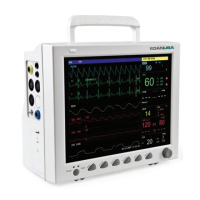Patient Monitor User Manual Monitoring SpO
2
- 123 -
14.5 Assessing the Validity of a SpO
2
Reading
You can check the quality of the pleth wave and the stability of the SpO
2
values to assess whether
the sensor functions properly and whether the SpO
2
readings are valid. Always use these two
indications simultaneously to assess the validity of a SpO
2
reading.
Generally, the quality of the SpO
2
pleth wave reflects the quality of the light signals obtained by the
sensor. A wave of poor quality manifests a decline of the signal validity. On the other hand, the
stability of the SpO
2
values also reflects the signal quality. Different from varying SpO
2
readings
caused by physiological factors, unstable SpO
2
readings are resulted from the sensor’s receiving
signals with interference. The problems mentioned above may be caused by patient movement,
wrong sensor placement or sensor malfunction. To obtain valid SpO
2
readings, try to limit patient
movement, check the placement of the sensor, measure another site or replace the sensor.
NOTE:
1. The SpO
2
accuracy has been validated in controlled human studies against arterial
blood sample reference measured with a CO-oximeter. SpO
2
measurements are
statistically distributed, only about two-thirds of the measurements can be expected
to fall within the specified accuracy compared to CO-oximeter measurements. The
volunteer population in the studies composed of healthy men and women from age
19 to 37, with various skin pigmentations. Note that the study population was healthy
adults and not in the actual intended use population.
2. The pulse rate accuracy is obtained by comparison to the pulse rate generated with
an arterial oxygen simulator (also an electronic pulse simulator).
3. During monitoring, if the monitor's reading differs significantly from the patient's
physiological condition, it indicates that the signal may be disturbed, resulting in an
inaccurate reading. In this case, the artifact can disguise as a similar reading,
causing the monitor to fail to send an alarm. In order to ensure reliable monitoring, it
is necessary to regularly check whether the sensor is wearing properly and the signal
quality is good.
14.6 SpO
2
Alarm Delays
There is a delay between a physiological event at the measurement site and the corresponding
alarm at the monitor. This delay has two components:
1. The time between the occurrence of the physiological event and when this event is represented
by the displayed numerical values. This delay depends on the algorithmic processing time and the
sensitivity. The lower the sensitivity configured, the longer the time needed until the numerical
values reflect the physiological event.
2. The time between the displayed numerical values exceeding an alarm limit and the alarm
indication on the monitor. This delay is the combination of the configured alarm delay time plus
the general system delay time.

